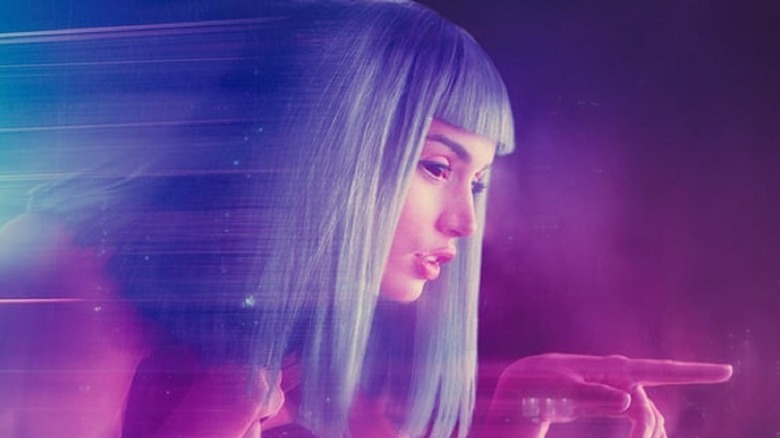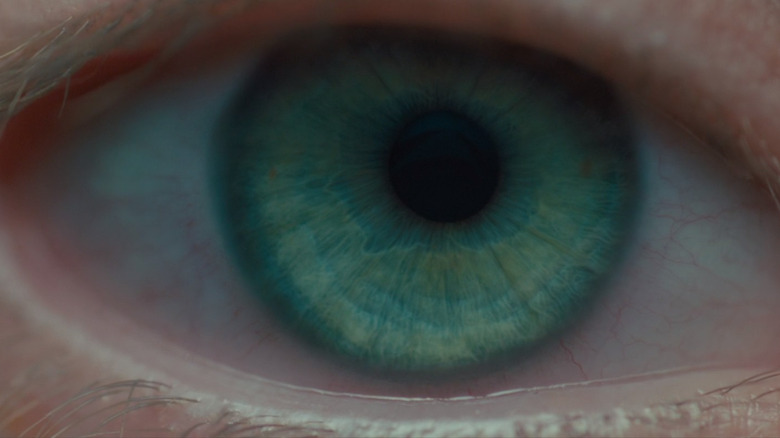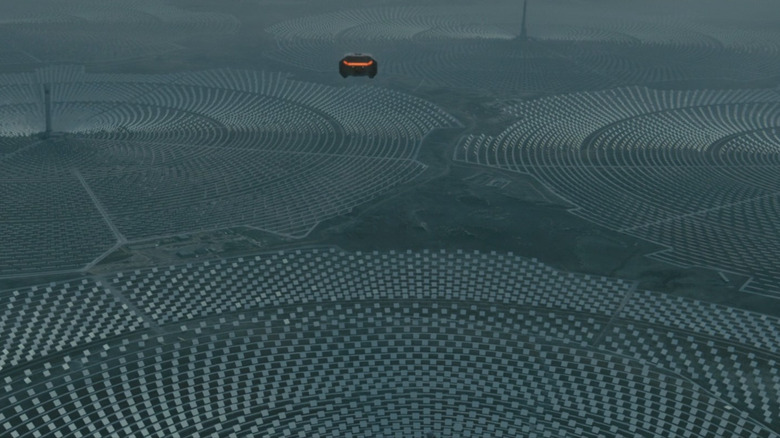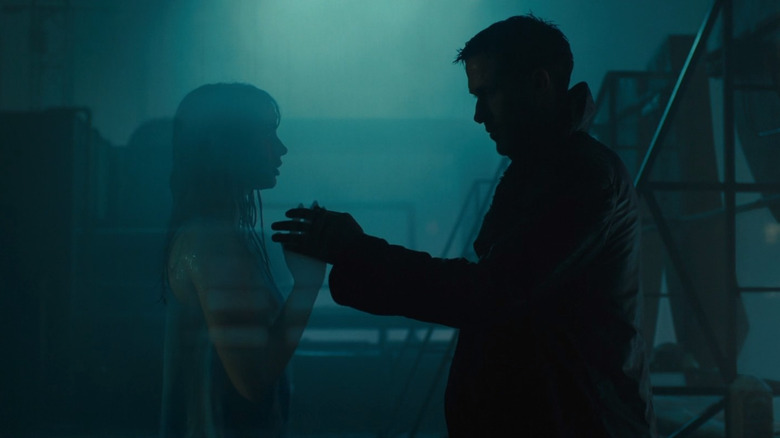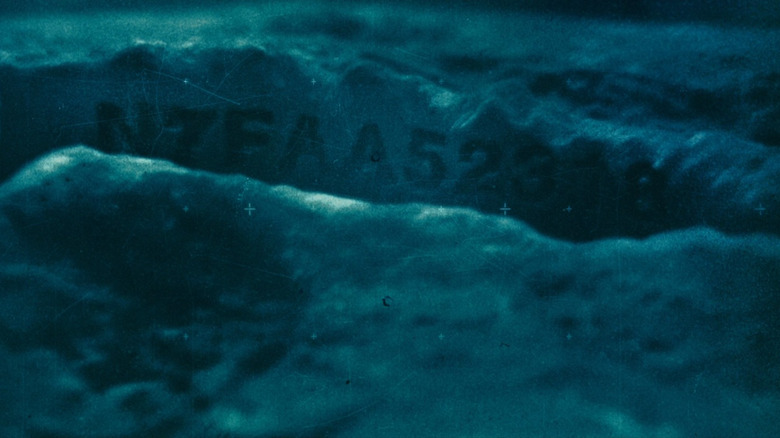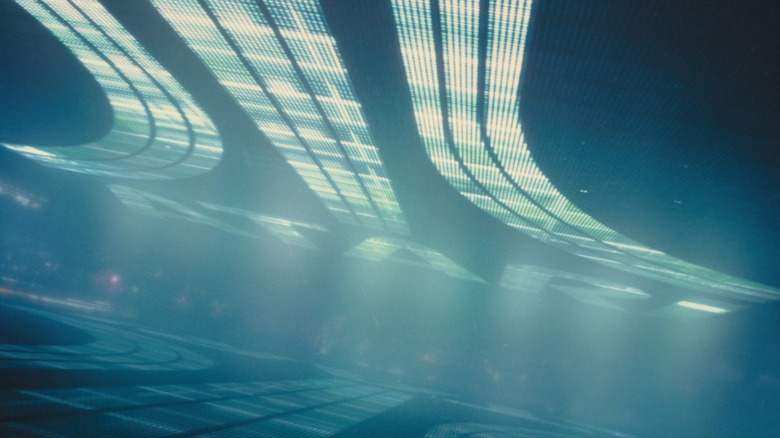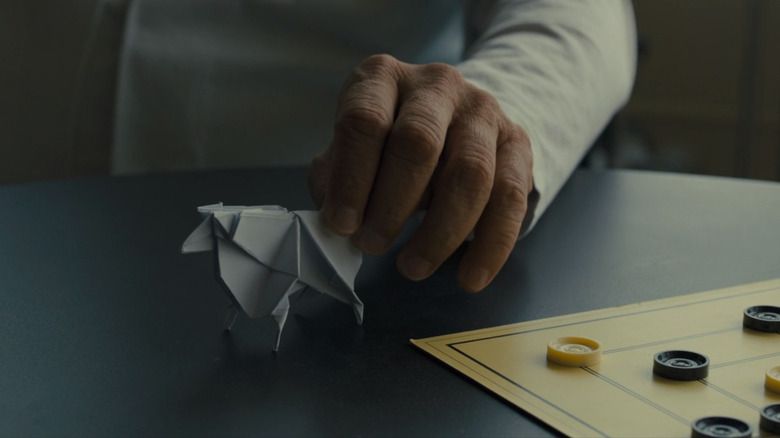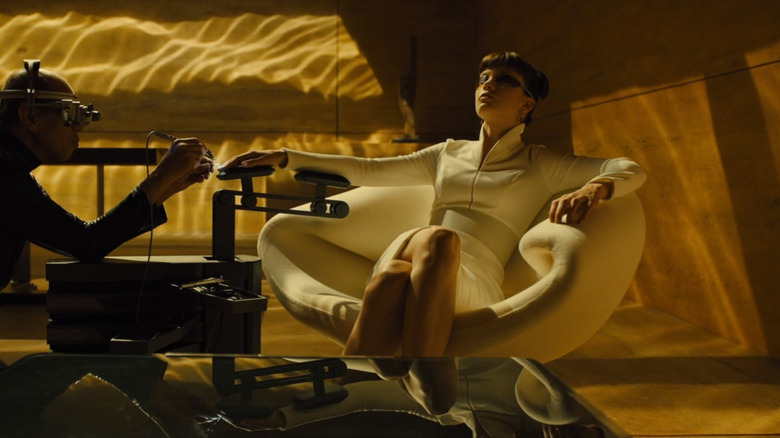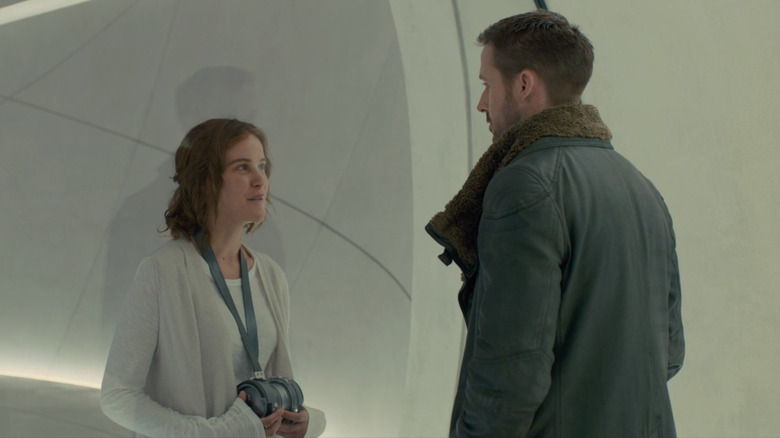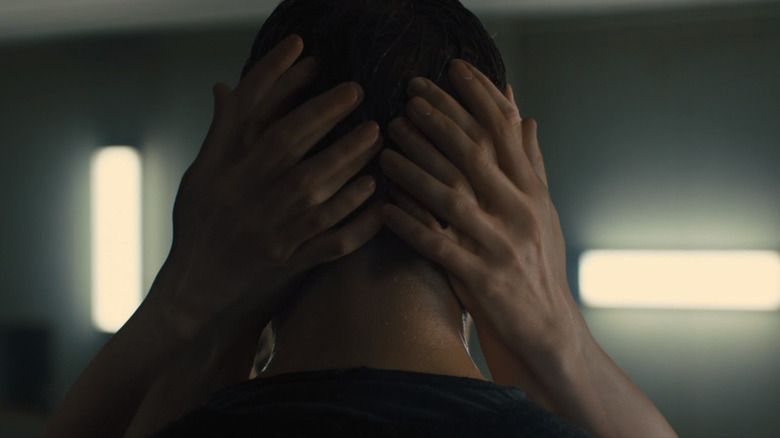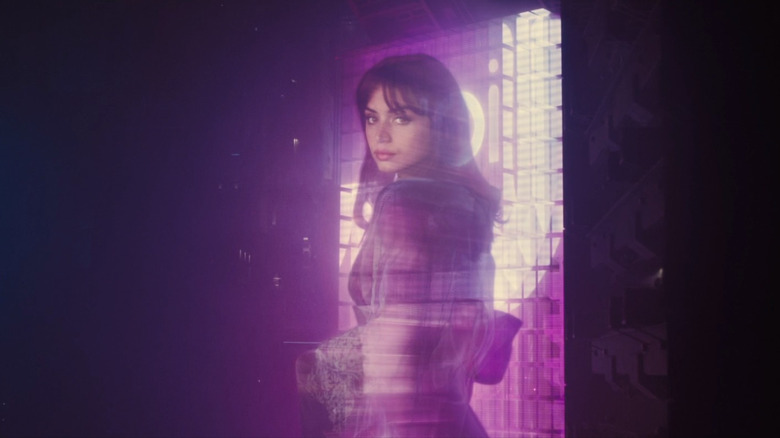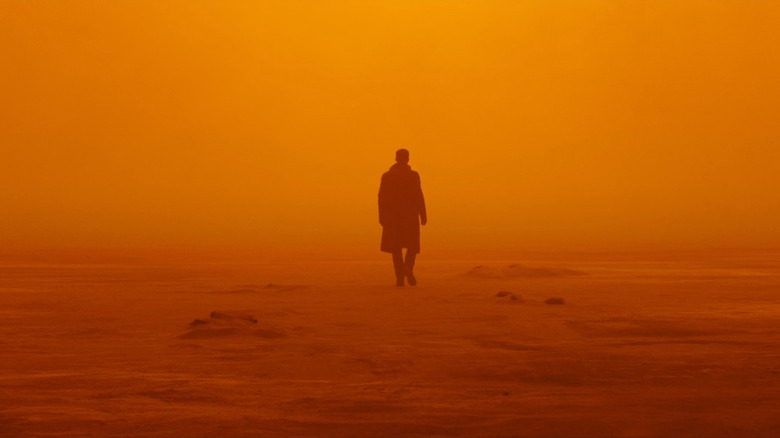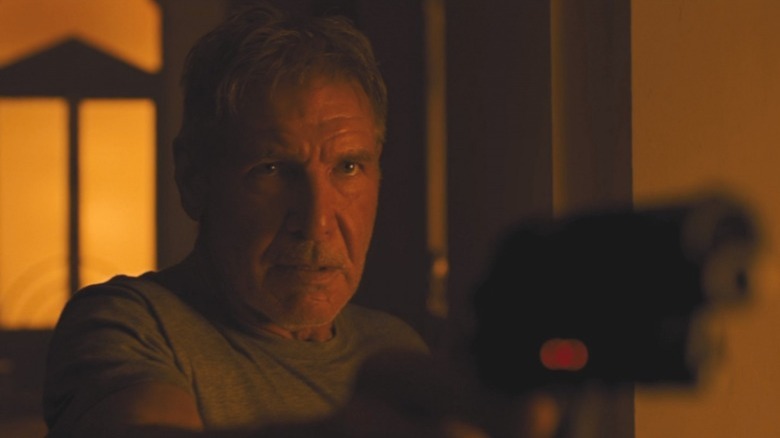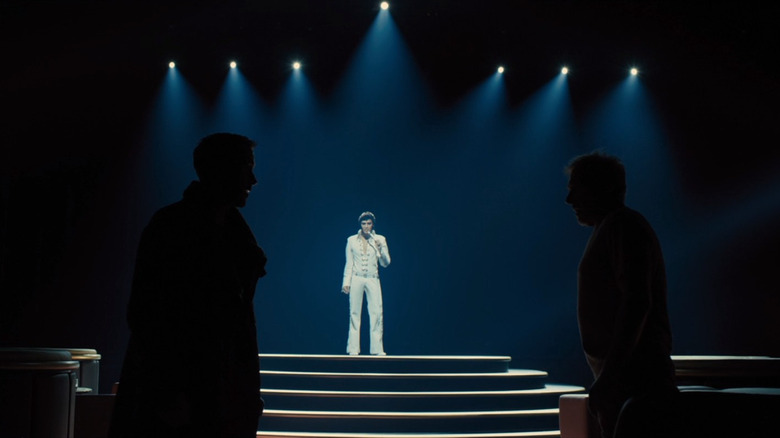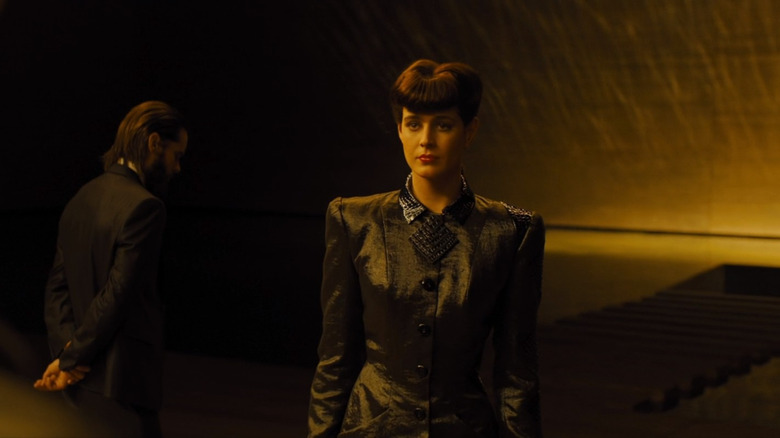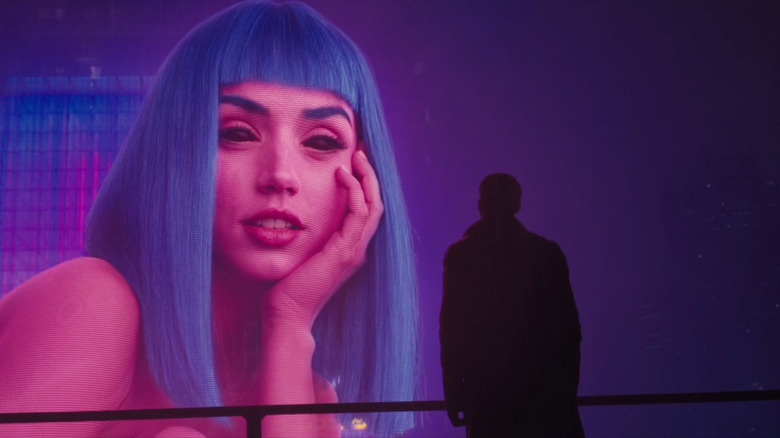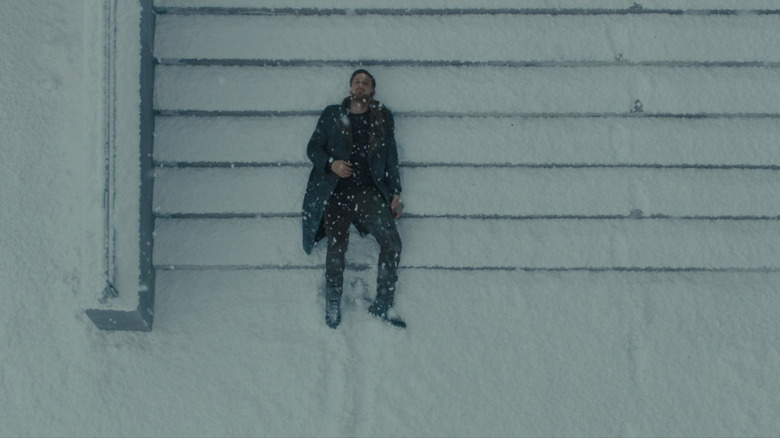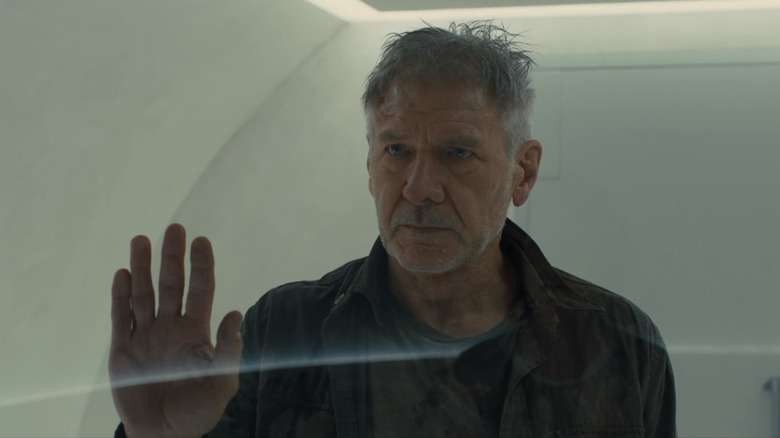The Most Pause-Worthy Moments In Blade Runner 2049
"Blade Runner 2049" is the rare sequel that's even more visionary than the original. Director Denis Villeneuve went even grander and more operatic than Ridley Scott's 1982 first installment, "Blade Runner" — in fact, Villeneuve took such a big swing he thought he'd ended his career when "Blade Runner 2049" bombed at the box office. Though it polarized fans (and critics) when it came out five years ago, "Blade Runner 2049" has aged well as its own unique story and a truly visionary epic that foreshadowed Villeneuve's eventual success with "Dune."
In contrast to the tighter, more claustrophobic style of Scott, "Blade Runner 2049" is full of wide shots that give a full sense of the ashen, industrialized world in which it's set. Villeneuve and renowned cinematographer Roger Deakins use a vast depth of frame along with stunning lights and colors to create one of the most dazzling science fiction movies ever shot. Multiple images are breathtaking as single static images in addition to containing gasp-inducing revelations and twists in an intricate story. These are the most pause-worthy moments in "Blade Runner 2049."
Her eyes were green
The very first shot of the film is a nod to the original "Blade Runner" film's obsession with eyes. However, instead of the grainy images of pupils from the Voight-Kampf test, "Blade Runner 2049" opens with a stunning shot of a densely detailed green eye. Later we'll see Agent K (Ryan Gosling) undergo an evolved version of the Voight-Kampf test where his own eyes are monitored to determine his "baseline," external measurements of his internal emotional reactions.
In the world of "Blade Runner," the eyes aren't just the window into the soul but the way to prove that you have a "real" one, or at least a human one. It's unknown whose eye opens the movie, it may be the eye of Ana (Carla Juri), the first child born of a replicant whose birth essentially represents an entirely new species "waking up." The lush and unforgettable green eye also foreshadows the way Deckard (Harrison Ford) knows he's only presented with a copy of his beloved Rachael (Sean Young) because "her eyes were green."
Endless fields of protein farms
Early on, "Blade Runner 2049" establishes itself as having a much wider lens than its predecessor in a literal sense. Agent K, on his way to try and bring in Sapper Morton (Dave Bautista), flies his car high above vast and endless fields of protein farms in rural California. The opening scroll of the film explained that Niander Wallace's (Jared Leto) protein harvesting technology saved humanity from starvation, but the movie soon shows us the true scale of what that looks like.
The bird's eye view of the film echoes the key difference of the "blade runner" that it's about. In the first movie, Deckard was a human (or was he?) down on the Earth, navigating the bustling and crowded streets. In "Blade Runner 2049," the perspective and tone of the movie adjust themselves to follow K, a replicant blade runner that's mostly dispassionate and removed from humankind. Often in his flying car, he glides far above the world and considers things from a remove.
Joi in the rain
Not content with just one kind of artificial intelligence, "Blade Runner 2049" introduces us to K's girlfriend Joi (Ana De Armas), a virtual companion with a consciousness just as alive as his own. At first confined to his apartment sort of like a holographic Alexa, K arrives home with an "emulator" that allows Joi to go anywhere that he does. The scene when Joi experiences rain for the first time is a delightful scene, as she shimmers in and out of view with the falling raindrops.
It also allows the movie to deliver the first of many futuristic gut punches, as Joi's rapture is interrupted by a phone call from K's boss and she freezes mid-kiss. The human intimacy that a replicant and a digital companion are trying to recreate, the spell of souls intertwining that anything alive enough will attempt to cast, gets broken by the dictates of the system. Back to work.
The serial number that breaks the world
It's just a small bit of effects work, the shot of a serial number barely visible in the bone fragments that K found buried on Sapper Morton's farm. But this is arguably the most important shot in "Blade Runner 2049," the revelation that "breaks the world," as K's boss Madam (Robin Wright) keeps loudly insisting. The remains of the pregnant woman that they've found are those of a replicant. Replicants can recreate!
This small detail is what drives the entire plot of the movie and could hold the key to colonizing the rest of the stars. We soon learn, tragically, that these are Rachael's remains, and that she died giving birth not long after the events of "Blade Runner." With a surprisingly casual scene of zooming in on a bone fragment, "Blade Runner 2049" upends our understanding of the line between replicants and humanity, and sets off a revolution in the process.
Media giant Atari
One of the most fun visual references to the original movie is the brief sight of a giant neon sign for the Atari corporation. Since "Blade Runner" was made in the 1980s heyday of Atari, it imagined that by 2019 it would become a media giant, and had signs in its world equating the company with the likes of Pan Am, RCA, and Bell Phones. In 1982, it would be impossible to imagine the world without Atari.
In our reality, Atari hasn't been a major cultural force for decades, having long since declined in the mid-'90s and gone through a series of bankruptcies and re-alignments in the 21st century. But in the world of "Blade Runner 2049," it has twin bill-board-sized signs that create one of the movie's best shots. Hundreds of happy consumers are probably playing games like "Space Invaders Volume 47" and "Great-Great-Grandson of Pac-Man."
Gaff's sheep origami
Edward James Olmos reprises his role of Deckard's fellow blade runner Gaff in "Blade Runner 2049," although he's long retired when K visits him. Although Gaff is out of the game and hasn't been in touch with Deckard for decades, he's still keeping up with his primary hobby: making origami figures that other blade runners find to be cryptic and vaguely taunting.
In "Blade Runner," he pokes at Deckard's courage with a chicken and makes him question his memory (and humanity) with a small unicorn. In the sequel, he makes another relevant choice and presents K with an origami sheep. K is one of the new "compliant" replicants made by the Wallace Corporation: compared to the replicants that Gaff hunted in his time on the force K is nothing but a mindless sheep. It's also a subtle nod to the original novel "Do Androids Dream of Electric Sheep?" which inspired the entire franchise.
Luv's way of relaxing
K's main antagonist, Wallace's trusted replicant Luv (Sylvia Hoeks), is more or less completely terrifying every time she appears on the screen. But her most striking scene is in repose when it's revealed that she's directing the missile strikes that save K from the scavengers that downed his car at the San Diego waste facility. While getting intricate designs etched into her nails, she mercilessly orders "fire" over and over in her calm, flat affect.
It's a terrific scene that reveals how thoroughly Wallace controls every aspect of society in "Blade Runner 2049." They have access to Los Angeles Police Department information in almost real-time, and they can track one of their officers via satellite and watch him get closer to the child everyone is looking for — even more than in today's world where your smartphone is always listening to you, privacy in this dystopian future is a completely foreign concept.
A boy and a girl
A neat shot portends an eventual crushing revelation in the scene where K first meets Ana, the memory designer. He needs her to tell him whether or not a certain memory in his head is fabricated or real, and she does tell him that "someone lived this," meaning it really happened. Crucially, she doesn't quite say that it happened to him.
We'll learn eventually that Ana is in fact the child of Deckard and Rachael, born on 6-10-21, the one that lived the memory and the dawn of a new race. Briefly, when they speak for the first time, Villeneuve frames Ana right within K's reflection in the glass between them — just as she'll eventually take his place in the story that he believed he was discovering. It's also an elegant representation of the way she's given K emotional life and consciousness by giving him a foundation of her own memories to create the reflection of humanity.
This modern love
In a love scene like no other, "Blade Runner 2049" creates a unique menage a trois with Joi, K, and a replicant named Mariette (Mackenzie Davis) that Joi has hired for the occasion. Paying off the genuine connection and longing that Joi and K have shown throughout the film, the scene is a surprising and tender interlude in a movie that's otherwise cold and ethereal. Heartbreakingly, Joi tells K she wanted to be "real," for him, like a sad science fiction version of the forlorn velveteen rabbit.
It's also visually one of the more stunning parts of the movie, as Joi and Mariette phase in and out of sync with one another in different moments. A truly psychedelic amalgamation of both actresses' faces and limbs waving in and through one another creates a love scene that's at once tasteful, emotional, and unlike anything in the "Blade Runner" franchise.
She's everything you want
Just as "Blade Runner 2049" surprises us with the love scene between Joi and K (with an assist from Mariette), it twists the knife in the very next moment as it cuts to a billboard that reveals Joi's true nature. Although it's been thoroughly hinted at with background images and passing comments, it's the first unmistakable proof we get that Joi is in fact a commercial product sold by the Wallace corporation.
It stands to reason that since Joi is an entirely digital creation unlike the physical replicants, there could be millions of copies of her. After seeing her wonderfully brought to life by Ana De Armas' performance and Joi's clear devotion to K, it's devastating to put together that it's impossible to tell if her love is genuine or just part of her programming. What does love mean if millions of other people have the exact same "person" at home, or in their pocket?
What happens here stays shrouded in radioactive mist
If there's a single shot that director Denis Villeneuve could point to as a sort of proof of concept for how great his "Dune" could look, it's this image of K walking into the red mist of the irradiated and abandoned Las Vegas. With only the origin of a small wooden horse and faint glimmers of life on his car's equipment to go on, he walks steadily into the unknown. Our stoic replicant plows on, even when he can't see where he's going.
The ruined Vegas has progressed far beyond the one we know, and there are many more spectacular visuals involved the crumbled remains of some giant erotic statues that follow. But it's this image, stark red and relatively bright after two hours of darkness, that is the most striking and signals that the movie has shifted into a new phase: a momentous meeting is on the horizon.
Many's the long night I've dreamt of cheese
Perhaps the greatest trick that "Blade Runner 2049" pulls is being so hypnotically original and distinct from its predecessor that when Deckard finally shows up you're doubly surprised. It's a thrill and nostalgic delight to see the character again, of course, in classic franchise revival fashion, but you're also so involved in K's quest that you kind of forgot that Deckard was even a part of it.
As gruff as ever, Deckard's apparently been chilling in Vegas for years with nothing to do but read, and adds to the dreamlike quality of the scene by quoting "Treasure Island." He chooses a quote from one of the most tragic characters, Ben Gunn, who's been marooned for years with a cave full of treasure that he's unable to spend. It's a fitting analogy for Deckard's like, drinking from millions of bottles of whiskey in an abandoned pleasure town with no one to share it with.
Some things are meant to be
After an absurd number of punches to K's face, Deckard stalls out and seems to finally realize that there's no point in fighting. In one of the most visually arresting sequences, their fight has been periodically interrupted by a glitchy, holographic Elvis Presley. Glimpses of the King and his backup dancers have disoriented K and Deckard as they stumble through the showroom, attempting to get the upper hand during a confusing mix of silence and Elvis's greatest hits.
Just when they're beginning to slow down, Elvis pops back up with a perfectly timed rendition of "Can't Help Falling In Love." It's exactly the right thing for Deckard to break the tension by remarking "I love this song," and for our once and current blade runners to agree to call off the fisticuffs and go get a drink. Nearly a century after it came out, one of the King's best songs is still bringing people together.
Rachel, resurrected
Art imitates life, as they say. The filmmakers of "Blade Runner 2049" use CGI magic to recreate a de-aged Sean Young in her role as Rachael, just as Niander Wallace in the story clones the original Rachael to tempt Deckard with a new copy of her. After the movie revealed her decades-ago death in the early going and then only presented scattered audio clips of her voice, it's truly gasp-inducing to see Rachael walk up to her old flame.
It's a form of torture to see her again, and it's clearly displayed on Deckard's bewildered and pained face. Like a bad dream, this Rachael asks if Deckard still loves her, which breaks the illusion slightly: the real Rachael would know that of course he does. And as Deckard points out, they got her eye color wrong to boot. Wrenchingly, this duplicate Rachael is unceremoniously shot in the head.
You look like a good Joe
Grievously injured and mourning Joi's recent "death" when Luv crushed her emulator, K is presented with a final and bitter reminder that his love was never "real" in a certain sense. A giant pink and blue hologram of the "Joi" product line speaks to him on the street. In the dystopian world of "Blade Runner 2049" advertisements don't just steal your data, they talk to you and make eye contact.
Oblivious to his grief, this Joi tells K "you look like a good Joe," which must cause his equivalent of a heart to sink even further. "Joe" was the name that Joi had suggested for him when he thought he was a "real boy," and this hints that even that special moment is something that might have been part of her copywriting instead of a genuine impulse. With the Wallace Corporation taunting him with all of the meaning that he's lost, K decides to go after Deckard to hit them where it hurts.
Dying on the steps
It's a tribute to Ryan Gosling's stellar performance that we feel so much for K as he's dying at the end of "Blade Runner 2049." Having sustained too many wounds in his last confrontation with Luv, he gets Deckard to Ana's memory lab at the upgrade center and assures him that he'll be fine. He then lays down on the steps in the falling snow and looks more content than we've seen him this entire time.
After a lifetime of dispassionately following orders, in saving Deckard he's finally done something that he wanted to do. He reunited a man with his daughter — a daughter that he understands in a peculiarly empathetic way since he shares some of her memories — and can rest knowing she's safe and could mean vast change for every replicant to follow. To paraphrase what Freysa (Hiam Abbass) said, dying for the right cause is the most human thing he could do.
Go meet your daughter
After nearly three hours, "Blade Runner 2049" ends with a sigh of relief and a moment of connection as Deckard meets his daughter for the first time. Dozens of important questions hang in the air: Is the replicant revolution nigh? Will Ana be able to leave her chamber? Will Deckard be able to escape the authorities without K's help? None of that matters at this moment.
The last shot is really the first time you can breathe after an entire film of reserved tension, and the humanity and weariness on Harrison Ford's face really make you feel the moment. He puts his hand on the glass, both in greeting and to attempt to bridge the many barriers between himself and his daughter, lost to him on purpose. Years, secrecy, and a vast conspiracy to hide the world-shattering fact of her birth from the system that it would threaten — none of it matters at the moment they finally connect.
